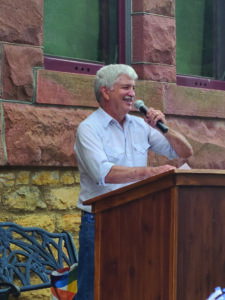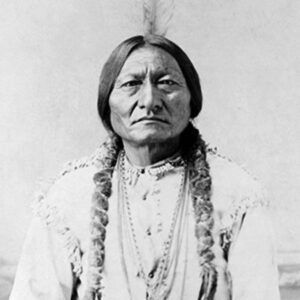Sitting Bull from a white perspective

Bill Markley
DEADWOOD—On a trip to Deadwood, the local History on the Lawn event, Bill Markey, a speaker from the South Dakota Humanities Council, spoke about a book he had written about Sitting Bull, Leaders of the Legendary West.
Markley talked about Sitting Bull’s tribe, the location on where they originally had settled, and how things were before the white man had intruded. Being from the Hunkpapa Lakota, he mentioned his Lakota name and how it meant more than just the whiteman’s translation, A strong bison when surrounded will sit on his haunches and fight to his death. Although considered a kind and generous man, Sitting Bull counted coup as a younger man, learned to hunt buffalo, loved children, and had five wives and up to nine children. Sadly, most did not live to adulthood. Sitting Bull was a holy man, believed to be able to talk to animals. Meadowlarks were a favorite.
Markley spoke of the Dakota War in 1862, as well the results with Sully and Sibley invading modern day South Dakota to catch up with the Dakota. Sitting Bull first squared off on the U.S. Army at Apple Creek in 1863, where he fought a delaying action. Sully would later sack another Sitting Bull camp, near the Cannonball River in present day North Dakota.
Sitting Bull would later catch a small contingent of straggler wagons coming across the gold fields, and would wipe out this small group. However, Sitting Bull would get shot during this engagement. It was after this time, the Americans started building more forts, including one at Laramie. When the 1868 treaty was signed by others, Sitting Bull asked for a consideration…no more steamboats, and no more forts. As such, Sitting Bull did not sign the Fort Laramie Treaty.
In 1869, the Lakota realized the whites were not leaving, so a council of non-signers, met, and appointed Sitting Bull as the war chief for their people.
About this time as well, a railroad, the Northern Pacific, wanted to go from Duluth Minnesota out to Tacoma Washington. This route would go through the Hunkpapa hunting lands, and negotiations were attempted in 1872…and Sitting Bull said no. The government felt Sitting Bull was bluffing, so they went ahead with their plans. At this time, the Hunkpapa were in the process of fighting the Crow, and the American military engaged the war party in the middle of the fight. Sitting Bull, unhorsed during the engagement, telling others he wished to smoke a pipe. In the middle of the battle, bullets flying, no one would be hit, but it had to unnerve the Army that this leader would stop in the middle of a battle, to smoke his pipe…and never be hit.
Surveys for the railroads would grind to a halt, as other Lakota bands would follow suit, bringing work to a standstill. Sherman would later stamp this railroad project important to the national effort, and even after an increased effort from the federal government to force the railroad across tribal lands, the furthest they would make it was to Bismarck, in Dakota Territory. About that time, the backers for Jay Cooke, who was the lead investor for the Northern Pacific, backed out, leading to the Panic of 1873, an economic depression felt back to the east coast.
In 1874, Custer embarked from Fort Abraham Lincoln on his famous gold expedition into the Black Hills. Upon finding gold, Custer established the premeditated pretext needed to ignite a rush of prospectors to the Black Hills. The Army knew full well they could never hope to stem the tide of gold fever, but had every intention of pretending they intended to fulfill that treaty obligation. Tribes were ordered to their reservations. Grant had sent out messengers to deliver this message to Sitting Bull. No one knew if he even received it in time, or that he would go over 200 miles to the so-called Agency, located miles from where they presently were camped.

Tatanka Iyotaka (Sitting Bull)
In 1875, tribes responded with a large sun dance, which saw the Northern Cheyenne, Hunkpapa, Oglala, Sans Arc and Minneconjou camp together. Sitting Bull had a vision, ‘he saw men, falling from the sky, head first, a lot of men. They were falling, into a Lakota Camp, as thick as grasshoppers. Sitting Bull, would see his camp grow as other bands formed a huge camp along the Greasy grass in southwestern Montana, and in 1876, Custer came across this large camp, with an estimated 10,000 people.
About a week prior to the battle, Sitting Bull had taken part in another sun dance, that saw him give over 100 pieces of flesh from his arms. He didn’t take a major pro-active part in the battle, at first giving his regalia to a son and asked him to go parlay with Captain Reno. When he discovered they were not in the mood to parlay, he helped get people moving in two directions. One was to attack Reno’s men, while the women and children were sent to safety a short distance away, so they couldn’t be captured.
In the aftermath, Sitting Bull would go into Canada, but after four years he returned to South Dakota, When Sitting Bull came in to Fort Buford to surrender, he gave his rifle to his son, Crow Foot, to give to Major David H. Brotherton, making note, that he was the last man of his tribe to turn in his rifle. He also stated, he wished his son would learn the new ways of the world. And with that, Sitting Bull was now on the reservation.
There was a short question and answer phase of the Deadwood event, questions were asked about the events surrounding his death, in which the author said “It could take another hour to discuss the events there,” But all in all, it was an interesting afternoon.
(Contact Joe Budd at sales2@nativesunnews.today)
The post Sitting Bull from a white perspective first appeared on Native Sun News Today.
